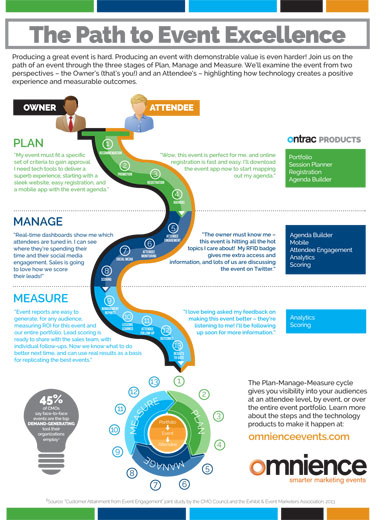RFID: A key technology for boosting a meeting’s ROI
Your event management system is the foundation upon which you can add sophisticated tools for attendee engagement, lead management, and performance measurement.
Two during-the-event technologies “set the table” for identifying each event’s best prospects and subsequently converting them to revenue:
- RFID (radio frequency ID) is the venerable mainstay technology that keeps getting better, constantly bringing new value to the art of tracking and mapping attendees’ whereabouts at a face-to-face event.
- Mobile is, relatively speaking, the “new kid on the block.” Vendors and marketers alike are exploring and trying to harness mobile applications for their engagement potential.
We’ll get into mobile technologies in a future post; in this post, let’s examine RFID.
Radio identification technologies date back to World War II, when the British put transmitters on their planes to identify them as friendly aircraft to ground forces. Today’s RFID works on the same principles, explained in layman’s terms by RFID Journal: “A signal is sent to a transponder, which wakes up and either reflects back a signal (passive system) or broadcasts a signal (active system).”
The cost of RFID “tagging” has plummeted over time. As a result, RFID has gained traction for a myriad of applications: access control, theft prevention, tracking goods through the supply chain, automatic toll payments, asset management, and many others—even tracking cows!
RFID was first used in the events industry in the early 2000s, according to PlanYourMeetings.com. In typical implementations, registration badges include RFID chips (“tags”) encoded with information about each attendee. Radio waves carry the encrypted information from attendee tags to antennas (“readers”) strategically placed throughout the venue. Software translates the reader-gathered attendee data into insightful reporting, which can be real-time or post-event.
Marketers are finding multiple ways to extract value from RFID-enabled events. Stay tuned— in the next post, we’ll delve into RFID’s ROI potential, as well as its key role in bridging the online/offline measurement gap.





2 Comments
Nice article Casey. I think the ROI potential is becoming much clearer for RFID in events. We’ve deployed some big RFID projects for events with companies like SAP, Sony Playstation and Adidas, each with different ROI objectives, but nonetheless deemed successful thanks to the value brought by RFID. You can find out a bit more about these and other RFID events projects at our website: http://exceleratedapps.com/
Thanks,
Richard
Thanks Richard, very good points indeed. The convergence and leveraging of various technologies (social, mobile, RFID, etc) is certainly important to consider in creating an engaging, valuable and measurable experience for attendees. Used well and with forethought, each complements the other. Without proper coordination, these valuable tools can frustrate the audience and provide little value to the event stakeholders.